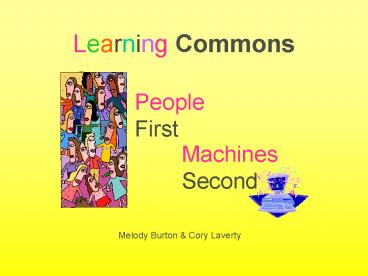Learning Commons - PowerPoint PPT Presentation
Title:
Learning Commons
Description:
Learning Commons. Machines. Second. Melody Burton & Cory Laverty. People. First. Learning Commons ... What services and facilities do you expect to see in an ... – PowerPoint PPT presentation
Number of Views:27
Avg rating:3.0/5.0
Title: Learning Commons
1
Learning Commons
Melody Burton Cory Laverty
2
Learning Commons
What services and facilities do you expect to see
in an Information or Learning Commons?
3
Dalhousie Learning Commons
4
Dalhousie Mission .. combines information
resources with advanced technology and brings
together expertise and resources necessary to
help students, faculty and staff successfully
integrate information with technology in their
academic careers.
- Dalhousie Services
- Reference and research
- Desktop support
- Geographic information services
- Statistical computing
- Math and stats satellite office
- Writing workshop (no info)
- Group study rooms
5
Calgary Information Commons
6
Calgary Mission core facility for provision of
information resources and information technology
services and technology to support the
effective identification, acquisition and use of
information resources development of
information literacy skills in the University
Community, especially undergraduate students, is
a key mission of the Information Hub. Competency
in the identification and evaluation of
information, the extraction and manipulation of
data, analysis, and presentation, are core
research skills.
7
- Calgary Services
- Instruction on productivity (MS Office ITS)
- Bibliographic software (Library)
- Health Science Library instruction (accessing
electronic journals, using Reference Manager) - Information Commons instruction
- library tours
- basic research skills
- using the Internet for research
- using article indexes
- search techniques advanced tips and tricks
- Course-integrated instruction
8
Experience in One Library
- Reference librarians involved in planning for a
Learning Commons in a large Humanities/Social
Sciences Library. - Our goals
- Support for information literacy development.
- Transform reactive reference desk to a proactive
learning environment. - Create strategic relationships with
complementary campus groups (Teaching Assistants,
Writing Centre, Learning Strategies, Special
Needs, ITS).
9
Focus Group Feedback
- Not a sea of computers.
- If this is about computers, dont do it!
- View library as service-intensive facility.
- Want help and ongoing support.
- Faculty want traditional library environment
retained. - Focus on people and learning not computers.
10
Components of Learning Commons
11
Components of Learning Commons
Partnerships Writing Centre Learning Strategies
Group Special Needs
12
Research Continuum
13
Information Literacy Development
14
Present Scenario
- Sociology 122
- 800 - 1,000 students.
- Research essay requiring 3 scholarly articles
including Canadian content and government
documents.
15
Learning Commons Scenario
- Curriculum Design
- Advance consultation with faculty on
assignments. - Map resources to assignments across program.
- Scaffolding
- Learning Strategies addresses time management
and process. - Reference Desk support peer support groups
within the class. - TAs / librarians hands-on sessions (tools,
RefWorks, plagiarism) - Tracking
- Students keep research diary.
- Targeted online tutorials.
- Synthesis and Reflection
- Writing Centre addresses thesis, argument,
citation style.
16
Staffing Model
- Serving humanities and social sciences
(7,000-10,000). - 5.5 core librarians, one ITS student, one
reference assistant. - Draw librarians from other units for desk
shifts. - Includes Head of Reference/LC Coordinator.
- Peer mentors to cover longer hours for basic
questions and trouble shooting. - One library technician to oversee computers and
technology.
17
Governance
- Discussion of LC coordinator as coming from
partner groups with no reference responsibility - Learning Commons replaces reference department
- No person in charge of programming for
information literacy and ensuring service quality
and integration - Longer hours required with existing staff led to
student peer program - Debate over technology run by library vs. ITS
18
Learning Commons
What elements would you want to take priority in
your Learning Commons?































